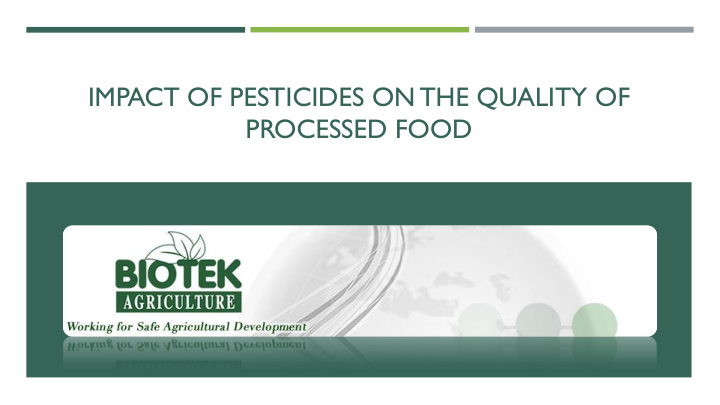



IMPACT OF PESTICIDES ON THE QUALITY OF PROCESSED FOOD
WHAT WE DO Processing laboratory for cereals (TROYES-FR) Malt and Beer; Bread and analyses on flour according to the French processsing CEB 218 guideline. Processing laboratory for fruits, vegetables and grape (NIMES-FR) Fruits and vegetables: canned, purée, jam, dried fruits and vegetables, essential oil, juice, cider; Wine (red, rosé and white): processing according to the French CEB 143 and EPPO 1/268 guidelines, Champagne process; Analyses folllowing biostimulants or adjuvants applications: demonstration of possible impacts; Additional analyses according to CEB-143 guideline: highlighting the impacts on wine microbiology.
MALTING & BREWING GLP RESIDUE TRIALS ON BARLEY & HOP MALTING
MALTING & BREWING GLP RESIDUE TRIALS ON BARLEY & HOP BREWING
ANALYSES ON GRAINS AND FLOUR ( AFNOR AND CEB FRENCH STANDARDS) Water content on grains and flour (fast • method or according to AFNOR French standard); • Grains specific weight (fast method or according to AFNOR French standard); Protein content (inframatic); • • Thousand gram weight; • Hagberg falling number;* • Sedimentation values according to Zélény;* Dough resistance with Chopin • alveograph.* *Analyses made according to AFNOR (French Association for Normalization) French current standards and results validated by BIPEA (Interprofessional Bureau for Analytical Studies)
BREAD MAKING ACCORDING TO NF-V03-716 - GEP
GEP/GLP FRUITS AND VEGETABLES PROCESSING – NIMES Semi-industrial or homemade process Analyses of qualitative parameters : pH, total acidity and volatile acidity, viscosity, Brix degree, color
WINE MAKING PROCESS: TRADITIONAL METHOD Studies under GEP & GLP guidelines Studies following marketing trials – wine process and taint tests Analyses of qualitative parameters on grapes and wine: pH, TAV, K+, sugar, SO2, AT, AV, color, anthocyanes, index of total polyphenol Laboratory certified by COFRAC for GEP & GLP studies
WINE MAKING PROCESS: SPARKLING/CHAMPAGNE METHOD Effects on the foam creation Ageing under controled condition Follow-up of the pressure increase all along the processs Suitable taint test
TAINT TESTS Thanks to our testing panel, we are able to proceed with: - Triangular taint tests according to the AFNOR ISO 4120 standard - Linear taint tests according to the AFNOR ISO 8587 standard
ADDITIONAL ANALYSES: MICRO-WINE PROCESSING Study on the evolution of the fermentation in synthetic condition or on must containing a fungicide
IMPACTS ON THE WINE MICROBIOLOGY Method of discs with the antifungal Same method but at different concentrations using lactic bacteria on the discs with yeast
QUESTION?
Recommend
More recommend